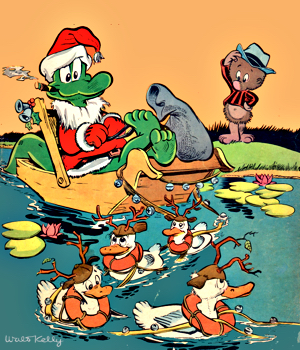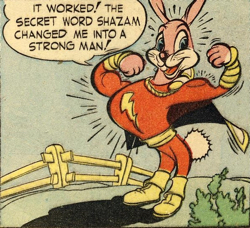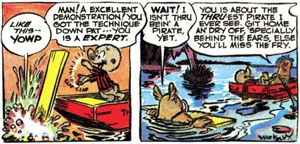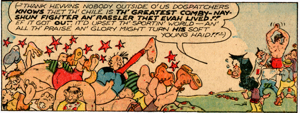Golly, Solly’s cold, and so’s old Lou.
Always the classics for the holiday. Be well and be safe and God bless us , everyone.
Always the classics for the holiday. Be well and be safe and God bless us , everyone.
 Let us forego our consideration of the green unicorn problem and, obeying the dictates of the season, direct our attention to that jolly old elf, Santa Claus.
Let us forego our consideration of the green unicorn problem and, obeying the dictates of the season, direct our attention to that jolly old elf, Santa Claus.
First, we’ll follow that which is not exactly required but is nonetheless highly recommended and seek to link the elf to comic books, this allegedly being a column devoted to the aforementioned magazines.
So: is Santa a comics character?
Yes and no. Research indicates that he and his cohort of elves and reindeer have never been awarded their own regular title. You could never find, tucked into your Christmas stocking, something like “The Adventures of Santa Claus” or if the comic was published by Disney, “Santa’s Funnies and Stories” or, if it appeared in the 60s and bore a Marvel colophon, maybe “The Stupendous Santa.” Santa has made – I’m taking a shot in the dark here – tens of thousands of comics guest appearances; I may have written a couple-three myself. But he has never been a regular at a comics shop near you. It’s almost as though he didn’t…exist?
And thus, finished with squirming, we come to it and dare ask: Is Santa real? (You might consider sending the children out of the room.)
Again, and please forgive me: Yes and no.
Begin with yes. There is a mythic/fictive entity whose existence was inspired by legendary folk who were probably real humans and whose lore has been augmented by uncounted artists, writers, actors, maybe dancers… anyway, a lot of creative folk. The first of these was an educated New Yorker who lived in what is now Chelsea, in lower Manhattan (and later in Newport) named Clement Clark Moore. He wrote what he titled A Visit From St. Nicholas, never intending it to be published. But it was, in 1823, by The New York Sentinel and it’s been with us ever since. (Some have disputed Moore’s authorship, but let’s not go there.)
 To continue: Are you certain you’ve shooed away the young’uns? Then let’s dare to face the no. So: no, there has never been an actual living human with sorrows, joys, aches and pains, a genome – none of that baggage. He was fiction, just like Spider-Man or John Galt or Hoppy the Marvel Bunny. But that’s not what many of us tell children. We say Santa is real and brings gifts and eats cookies and drinks the milk if we leave snacks out for him. We lie. Tsk
To continue: Are you certain you’ve shooed away the young’uns? Then let’s dare to face the no. So: no, there has never been an actual living human with sorrows, joys, aches and pains, a genome – none of that baggage. He was fiction, just like Spider-Man or John Galt or Hoppy the Marvel Bunny. But that’s not what many of us tell children. We say Santa is real and brings gifts and eats cookies and drinks the milk if we leave snacks out for him. We lie. Tsk
But for much of my life, I thought that the Santa fib was essentially harmless. I’ve changed my mind. What do we gain by teaching kids that adults perpetrate senseless lies that continue for years? That adults, and especially authority figures, are not to be trusted? That the world is full of uncertainty and that the people you love will, just for the heck of it, lie their asses off?
Maybe our final answer is yes Let the urchins learn to be careful and cynical and suspicious. Because look at the world we’re handing them.
Ho ho ho.
When I stop to think about it – and, obviously, I just did – it’s a miracle I’ve learned how to write and speak American English… at least to the extent that I have.
 Like a great many comic book fans, I was a precocious reader. This was long before The Simpsons’ Comic Book Guy was revealed to be in Mensa – an organization that could double as ground zero for Geek Culture. I learned how to read because my sister is almost seven years older than me and she got stuck with the chore of babysitting. Marcia would read me her comic books and I quickly discovered the comics page in the old (and deeply missed) Chicago Daily News. Between the newspaper and my sister’s comic books, I became an incessant reader.
Like a great many comic book fans, I was a precocious reader. This was long before The Simpsons’ Comic Book Guy was revealed to be in Mensa – an organization that could double as ground zero for Geek Culture. I learned how to read because my sister is almost seven years older than me and she got stuck with the chore of babysitting. Marcia would read me her comic books and I quickly discovered the comics page in the old (and deeply missed) Chicago Daily News. Between the newspaper and my sister’s comic books, I became an incessant reader.
The problem was, that newspaper carried such brilliant strips as Pogo, Li’l Abner, and Abbie an’ Slats. Many of the characters in those strips didn’t speak American English or British English or any other recognizable form of our mother tongue. Pogo and Albert and friends spoke Okefenokee Swamp English, a dialect so thick it would baffle Tennessee Williams. Abner, Daisy Mae, “Bathless” Groggins, and Slats Scrapple spoke a particularly cloistered version of hillbilly. Both Li’l Abner and Abbie an’ Slats were created and written by Al Capp, although Capp gave the A&S writing chores over to his brother Eliot Chaplin after World War II.
 As you can see from the art scattered around these words, they simply did not have United Nations translators for these features.
As you can see from the art scattered around these words, they simply did not have United Nations translators for these features.
The Daily News carried other strips, of course, but those three were among the truly brilliant. I also enjoyed Louie – a pantomime strip that, by definition, was bereft of dialogue.
I suspect my love of Golden Books was the counter-influence that put me on the straight-and-narrow. I graduated to biographies, which I love, and then to science-fiction and heroic fantasy and history. All of this happened because my sister read me her copies of Superman, Katy Keene and Mutt and Jeff.
So it is no surprise that I am a huge supporter of early reading programs. I’ve done a great deal of youth social service work in my life, and I’ve taken every opportunity to help such programs as Head Start, Reading is Fundamental, and Literacy Volunteers.
I remember when, back before Coggia’s Comet was discovered, the legendary Maggie Thompson wrote about how she and her husband Don used comic books as reading tools in raising their family. Damn, that worked out fine. It was difficult for me to convince some that comics would be useful in this endeavor back in my earliest days, but with great movie box office comes great acceptance. Drop a copy of Ultimate Spider-Man Magazine or Scooby-Doo Magazine in a kid’s lap and help the child read it. Discuss the stories afterwards. Watch their sense of wonder grow right before your very eyes.
Not only will you be forging the next generation of readers, but you will be keeping the sundry literary markets alive. That includes comic books, which easily could be replaced by superhero movies and television if we don’t get circulations boosted up.
This, in turn, will inspire the next generation of comics creators. It will be wonderful to see where the post-Millennials can take us.
 I’m a fossil. I know it. Proof positive: I read the daily newspaper. Not on a pad or tablet or my computer, I go out and actually buy the blamed thing. I read it during breakfast. Yes, I still get a certain percentage of my news from the computer and/or Jon Stewart and The Daily Show but I like having the physical newspaper, just as I prefer actual books to an e-reader. If I don’t get to read the paper, I get cranky. Or crankier.
I’m a fossil. I know it. Proof positive: I read the daily newspaper. Not on a pad or tablet or my computer, I go out and actually buy the blamed thing. I read it during breakfast. Yes, I still get a certain percentage of my news from the computer and/or Jon Stewart and The Daily Show but I like having the physical newspaper, just as I prefer actual books to an e-reader. If I don’t get to read the paper, I get cranky. Or crankier.
I think I got that from my father, Joel W. Ostrander Sr. He was always the first up in the morning but, during my high school years, I was up second. We’d both be at breakfast and we would read the newspaper. I’d get the sections he was done with; that’s where I learned to be possessive about my newspaper. If I buy the newspaper, you get it when I’m done. If you want to read it sooner, go buy your own.
Dad and I would have breakfast and read in a comfortable silence unless my mother decided to get up early and join us. Mom was a talker in the morning. Worse, she would expect you to talk back and on the topic she started so you had to listen. You couldn’t just fake it or grunt replies. She expected coherent sentences. I can do that in the morning but it takes an effort and more concentration than I care to give. Just let me read my newspaper and no one gets hurt.
When I move to a new location, I always have to decide which of the available newspapers I’m going to read (assuming I have a choice which is increasingly becoming difficult as newspapers fold up). So I have to choose which newspaper is going to be my regular. While the editorial bent is an important factor (politically left of center is a prerequisite), the determining factor is usually what comic strips they have. I was raised on the Chicago Tribune but I would also buy the Sunday Chicago American because I enjoyed the comics there. Dad would bring home the Chicago Daily News in the evening so, all in all, I got a goodly number of strips.
Chester Gould was still doing Dick Tracy when I was younger (my buddy Joe Staton now draws it) and Harold Gray was doing Little Orphan Annie. Al Capp was doing L’il Abner, Hal Foster was doing Prince Valiant, Walt Kelly was doing Pogo, and Milton Caniff was doing Steve Canyon. I don’t know if music was better back then but, yes, the comic strips certainly were. Perhaps even more than the comic books I read, comic strips were influential in my development as a writer, especially in graphic literature.
Some of the strips are no longer around. Leonard Starr’s On Stage was beautifully drawn and wonderfully written. I would later come across the British strip Modesty Blaise, created by Peter O’Donnell and drawn by a succession of artists following Jim Holdaway, who drew it first. I read those still not only for pleasure but because O’Donnell was a master of the medium. He knew how to pace and drive a story, wasting nothing, with every line forwarding the plot or the characters in a minimum of words. Elegant and compelling.
These days, there are very few adventure strips or strips with a continuing narrative and that’s a pity. Mostly, it’s gag and humor strips although some strips have picked up that narrative aspect. For example, Luann – created, written and drawn by Greg Evans – started out as a gag strip but has developed into a narrative, with the characters allowed to age and change.
Some strips these days are minimally drawn, such as Dilbert by Scott Adams. The drawing is competent although I get the feeling some panels are simply repeated over and over again but the writing is generally sharp and satiric. Pearls Before Swine by Stephan Pastis also has minimal drawing although, again, the writing is generally sharp and funny. Mutts, written and drawn by Patrick Mc Donnell, is a modern classic; better drawn although sometimes the writing is not so sharp. Non Sequitur, by Wiley Miller, is unique – sometimes it is a single panel drawing and sometimes it’s a sequential strip. It has continuing characters but it also has many stand alone installments. This one is also superbly written and drawn and benefits, I think, from Miller’s work as an editorial cartoonist. He packs a lot into a little space.
Some strips, unfortunately, are wretched, badly drawn and almost incomprehensible. That was always true, however, and there’s good reading to be found even today. Almost all of them are also available somewhere on the Internet but I still enjoy reading them in the newspaper if I can. There’s a tactile pleasure in holding the newspaper and experiencing them that way. I recommend it.
As they (used to) say, see you in the funny papers.